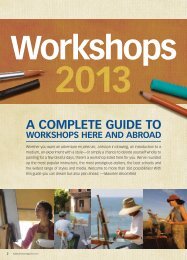STALWARTCargo Carrierby John NorrisIn the 1950s, the Coventry-based company of Alvis decidedto use its experience in designing military vehicles to developa cargo-carrying vehicle for the British army as a privateventure. The company had not been officially approached by themilitary to request the vehicle and Alvis was taking a risk indeveloping a vehicle which the army may not have even wanted.However, the company must have identified a need even ifthe army did not admit it and went ahead with the developmentprogram. What resulted became known as the “Stalwart.” Thedesign incorporated many of the cross-country capabilities andautomotive systems of Alvis’ earlier 6x6 vehicles (the Saladinarmored car and the Saracen APC), which were both in servicewith the British army.The first version of the Stalwart was produced in 1959 andgiven the designation FV620, but was later changed to FV621when the first production vehicles of the Stalwart were builtas the Mk 1. When it entered service with the British army in1966, the all-round versatility of the vehicle was immediatelyrecognized.Nicknamed the ‘Stolly’ by the troops, the Stalwart was a6x6 wheeled vehicle which could deal with a range of obstaclesincluding vertical steps up to 600mm (nearly 2 feet), crosstrenches of over 4 feet and cope with gradients up to 60% andside slopes of 40%. It was operated by a driver and two seats foradditional crew were fitted, but not all those who operated thevehicle liked it. Opinions were divided, with some drivers beingvery critical in their assessments. Entry to the driver’s cab wasby means of hatches in the roof and the driver sat in the middle.The cab was fitted with a large windscreen, which gave goodvisibility, and large wiper blades to keep the glass clear.The vehicle had an unusual configuration, such as the hulland chassis location. The engine was a Rolls-Royce B-81 Mk8BThe Stalwart was a rugged, amphibious, high mobility allterrainload carrier. As a cargo carrier the Stalwart was bulkybut it was sturdy enough to cope with an extreme range ofterrains.14 www.militaryvehiclesmagazine.com
6.5lt petrol and it was mounted behind the driver’s cab and underthe cargo load deck. The engine was rated at 220hp at 3750rpmto produce road speeds of around 40mph. The transmission anddifferentials were located in front of the engine and the vehiclewas fitted with five forward and five reverse gears. Whenentering water in its amphibious role the Stalwart could reachspeeds of up to 6mph by means of two water-jet thrusters. Itwas steered by using the steering wheel. A later version of theStalwart, the Mk 2 General Service (known as the FV622), wasfitted with more powerful thrusters to produce speeds of up to10mph when engaged in amphibious operations.The Stalwart had a kerb weight of 9 tons and could carrycargo loads of up to 5 tons. Although it had a wheel basemeasuring 10, feet the vehicle had an overall length of 20 feet10 inches. It measured 8’ 7” in width and 10’ 3” to the top ofthe cab and had a fuel capacity of around 100 gallons. TheStalwart had an operational range in excess of 500 miles. Thebows of the cab were well-angled to enter the water and exitfrom rivers by climbing the banks using its ability to scalesharp inclines.The large rear cargo-carrying deck area was fitted withdrop sides, which were fitted with seals to prevent the vehiclefrom flooding. Although designed specifically as a cargo carrierto transport fuel, ammunition and other supplies, the Stalwartcould transport up to 30 fully-equipped troops in an emergency.The Mk 2 FV622 was fitted with improved windows in thecab and could carry up to 38 troops. The FV623 “Limber” wasfitted with an Atlas hydraulic crane (rated to lift loads of 3 tons)behind the driver’s cab to help ease the handling of loads duringloading and unloading. The Stalwart could also tow loads of upto 10 tons, such as pieces of artilleryand trailers with ammunition.Apart from the basic Mk 1FV621 and the other versions of theFV622 and FV623, there was anotherspecialised version developed forthe Royal Electrical & MechanicalEngineers. This is a Corps unit of theBritish army and was formed in 1942.Today, the seven battalions maintainthe complex weapon systems of thearmy and the whole range of otherelectronic equipment to keep the armyoperational.The version of the Stalwartdeveloped for the REME was theFV624. It was fitted with twoadditional seats for crew and a heavierlift crane to cope with engines on the armored vehicles.The vehicle was only ever used by the British army anddeployed to those areas where its services were required,including the former West Germany as part of the British Armyof the Rhine (BAOR) to transport equipment and supplies acrossthe many rivers there.The large flat cargo area of the Stalwart made an idealplatform as a work area or to permit systems to be mounted, suchas battlefield radar and weapon systems, like the British army“Ranger” anti-personnel mine-dispensing system. The StalwartThe large driver’s cab could easily accommodate threepeople and the windscreen gave good visibility althoughthe ‘blind spot’ close to the vehicle was a problem thedriver could be guided by a man giving directions.The Stalwart had good amphibious qualities and this trio of vehiclesbetween them could transport either 15 tons of supplies or almost100 men with all their equipment. A “freeboard” device was loweredin front of the vehicle when engaged in amphibious operations toprevent the ‘wash’ from splashing up the obscure the driver’s vision.The freeboard device did obscure the driver’s vision when exitingthe water when climbing river banks and so the co-driver wouldcall down directions from his position on the roof. Very basic but itworked well. Ministry of Defensewas never armed, but when engaged in deploying mines, itprovided support in its engineering role and supplemented themore specialised vehicles engaged in laying mines .Because of its role and operational duties took thevehicle off-road and into some extreme terrain, the Stalwartbecame a high maintenance vehicle. Indeed, the vehiclewas not without its faults and heavy use led to a numberof automotive parts wearing outvery quickly. The Stalwart wasgradually phased out of serviceduring the late 1970s onwards.Its role has been taken over byhelicopters and the like.Around 1,600 Stalwarts of allvariants were built. Today, many arein private ownership. The owners areaware of the mechanical servicingrequired and for that reason theytend to move the vehicles longdistances on low-loaders.Like the other two 6x6 vehiclesin the range developed by Alvis, theSaladin and the Saracen, the Stalwarthas also been used in films andtelevision programs such as Tankboyand Firefly. Film credits include Tomb Raider: The Cradleof Life and Children of Men. Stalwarts do come up for sale. Oneowner who recently put his FV624 REME version Stalwart upfor sale was seeking £6,500GBP (or a little over $10,500). Thishad less than 1,000km (about 621 miles) on the clock. The ownerhad used it during the 2007 floods in Tewkesbury in Gloucestershire,UK, to rescue flood victims.Occasionally Stalwarts are used to give vehicle rides togroups and, apart from showing their mobility at vehicle events,can be seen as exhibits in military museums. ✪Military Vehicles Magazine June 2013 15
- Page 1: 01 02 03 04 FnL1 Qy1BDDA3NDQ3MDUwMj
- Page 7 and 8: NOS Wiring Harness for M101 Trailer
- Page 9 and 10: BMG Parts CompanyMachine Gun Mounts
- Page 11 and 12: IOLFI & PartnersAIOLFI & PartnersCA
- Page 13: Sponsor and ParticipantD & L BENSIN
- Page 17 and 18: The Findlay ShowMay 17 - 19, 201326
- Page 19 and 20: Military Vehicles Magazine June 201
- Page 21 and 22: Military Vehicles Magazine June 201
- Page 23 and 24: Specializing in Jeep and DodgeParts
- Page 25 and 26: Specializing in Jeep and DodgeParts
- Page 27 and 28: were on offer. There were all sorts
- Page 29 and 30: the cab. Rather unusually the body
- Page 31 and 32: Peter DeBella Jeep ® PartsNew Prod
- Page 33 and 34: Portrayal Pressest. 1980World’s L
- Page 35 and 36: As mentioned in Part One, it’s he
- Page 37 and 38: ONE OF THELARGESTVINTAGEMILITARYTIR
- Page 39 and 40: The Nation’s Largest Army Truck &
- Page 41 and 42: Military Vehicles Magazine June 201
- Page 43 and 44: The Largest ALL MILITARIA show in C
- Page 45 and 46: ROADSIDE TESTS FOR M-SERIES VEHICLE
- Page 47 and 48: BEACHWOOD CANVASMBGPWCanvas and Par
- Page 49 and 50: Eastern Surplus&Equipment Co.Call T
- Page 51 and 52: 17270 120Davis Rd., PO Box 565, Sum
- Page 53 and 54: I Have Or Can Get WhatYou’re look
- Page 55 and 56: 283 Persimmon tree lanep.o. box 214
- Page 57 and 58: ★ ★ ★ ★ ★ ★ ★★ ★
- Page 59 and 60: Ramshorn Creek RestorationRamshorn
- Page 61: army jeep parts, inc6500 BEAVER DAM
- Page 64 and 65:
DON’T MISS THIS ANNUAL EVENT. SAV
- Page 66 and 67:
66 www.militaryvehiclesmagazine.com
- Page 68 and 69:
etween 1936 and 1938. TheThe vehicl
- Page 70 and 71:
MILITARY VEHICLEPRESERVATION ASSOCI
- Page 72 and 73:
Arctic circle just to say, “We di
- Page 74 and 75:
The group traveled about 200 miles
- Page 76 and 77:
1 SURPLUS DRIVEWRIGHTSVILLE, PA 173
- Page 78 and 79:
From Rommel’s Afrikakorpsby Steve
- Page 80 and 81:
RAPCO PARTS COMPANYVisit us online
- Page 82 and 83:
VintagePartsAvailable!!Looking for
- Page 84 and 85:
HALF TRACK GAS CAP ADAPTER, new gas
- Page 86 and 87:
RANCHERS SUPPLYCOMPANYLAMAR, COLORA
- Page 88 and 89:
SPRAY CAN (16 oz.) $ 5.005.00SIX-PA
- Page 90 and 91:
C&C EQUIPMENT, LLCM35 2.5 ton locko
- Page 92 and 93:
BERG MILITARYTIRES, LLCUSED TIRES,
- Page 94 and 95:
1963 M37B1Excep onal earlierrestora
- Page 96 and 97:
M274 MULES & PARTSFOR SALE40 Mules
- Page 98 and 99:
LET US DO IT, WE KNOW HOW! LET US D
- Page 100 and 101:
New LifeAlways theBest Quality &Val
- Page 102 and 103:
2121 N.W. 2nd AvenueFaribault, MN 5
- Page 104 and 105:
PRICE REDUCED! 1 1/2 TON Chevy Carg
- Page 106 and 107:
AAdirondack Dodge Parts .......98Ai
- Page 108:
For any WWII VehicleBRIDGE PLATE KI







![Index [media2.fwpublications.com] - F+W Media](https://img.yumpu.com/45216355/1/190x245/index-media2fwpublicationscom-f-w-media.jpg?quality=85)








